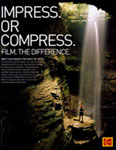|
|
 
|
|
Author
|
Topic: How Much Difference Does Film Make in HDTV?
|
|
|
|
|
|
|
|
|
John Pytlak
Film God

Posts: 9987
From: Rochester, NY 14650-1922
Registered: Jan 2000
|
 posted 01-18-2006 08:29 AM
posted 01-18-2006 08:29 AM





Cinematographers' Test
quote:
The Cinematographers' Test compares film and 24P
On the set.
"I participated in this test because I care about the future of our art form," says Aaron Schneider, ASC, one of three cinematographers who took part in a comprehensive test comparing images recorded in 35mm film and high definition 24P digital video formats.
Schneider was referring to his motivation for participating in The Cinematographers' Test, which premiered at the Academy of Television Arts and Sciences theater in Los Angeles. John Bailey, ASC, and James Chressanthis also contributed to the project. Following the premiere, the three cinematographers discussed their rationales for selecting different scenes for comparing the two formats and offered insights into the importance of differences in nuances rendered in colors, contrast, texture, focus and other characteristics of the images.
Some shows have to use a mix of formats:
Tales from the HD Trenches
quote:
Online assembly and finishing for HD, though, remains a thornier issue, regardless of how the images are acquired. At Hollywood Digital (a Liberty Livewire facility), Bob Williamson says his job is “pretty standard” on certain shows, and “markedly different” with others, largely depending on the genre and creative needs of a particular program.
On JAG, for instance, it is routine to use large amounts of standard-def stock footage and some digital effects, all of which can present a host of problems for the online editor because he is forced to work in both the HD and SD worlds simultaneously.
“JAG is largely film-acquired, but they regularly use stock elements and effects, and the stock might often come to us in 16mm or any of a number of video formats,” says Williamson. “Dealing with that stuff can be a daunting task. We have to up-rez those shots in the proper aspect ratio, since that stuff is almost always coming to us at 4x3. Then, we have to make creative decisions about which part of the frame to use when you up-rez it. We don’t want to be in a situation of having to up-rez and then down-rez again if we can possibly avoid it, so we always try to keep those elements in the standard-def post stream and cut them directly into the SD version of the show. We try to avoid going up-and-down because you can harm the image that way. If you took a stock NTSC shot of an aircraft carrier, for example, and up-rezzed it to fit the 16x9 frame, it usually softens a bit in the up-rez, and you lose a bit of the top and bottom. Then, to down-rez that back to 4x3 NTSC for broadcast—since the network airs a 4x3 edge cut of the 16x9 master—you can cut off the sides again and lose more of the image.”
| IP: Logged
|
|
|
|
|
|
|
|
|
|
|
|
|
|
|
|
|
|
|
|
Don Bruechert
Mmmmmmmmm, bird!

Posts: 340
From: Manitowoc, WI, USA
Registered: Jan 2003
|
 posted 02-03-2006 07:07 PM
posted 02-03-2006 07:07 PM





OK, FWIW, here is the scoop. Yeah, yeah... I came out of the closet... But I've been an A/V geek longer than the 2 years I was a film geek...
It all has to do with the bandwidth that is allocated to the program that you are watching. The truth about HD, at least right now, and allowing a wide latitude for the competence of your local broadcasters, is that you will usually get a much better and much better HD presentation off the air from your local station that you will from your satellite or cable provider. Next in line is cable, which in most cases allocates higher bandwidth to HD than do our friendly satellite providers.
To my knowledge, at one time it was rumored that Voom was providing the best HD bandwidth of those up there, and Direct and Dish were running pretty close - with one eeking out the other on occasion. Cut me some slack if you know the numbers better than me, but for the purposes of illustration, an HD signal is ideally transmitted at 14 - 18 MBps. Generally if you are watching programming sent out in this range it's going to knock your socks off. Your local off-air afilliate is not as limited in the power they have and they are not transmitting as much at one time so they ship it out at a higher bandwidth which can really look great (unfortunately a lot of them also don't know how to run the equipment so you end up with lip sync problems and other picture degrading things), but the satellite folks are transmitting off a satellite that might be shipping 150 channels, and they only have so much power and so many transponders to send them on. So they "multiplex" and compress the bandwidth they have so they are sending many channels on each transponder. If I remember correctly, a transponder is rated at somewhere around 24MBps. In an ideal world they would send one HD channel per transponder and there would be plenty of extra "headroom" for a few regular channels in there as well. If you're lucky they send 2 at a time and your bandwidth per channel is still running 12 - 13 MBps, which isn't all that bad, actually, but more recently they have been cramming 3 on there - which drops the bandwidth to around 8MBps per channel.
When it gets that low the picture really starts to suck. The people on the A/V geek forums (avsforum.com) call it "HD Lite" and piss and moan at the unfairness that they have to pay $10 extra a month to get that crappy signal. The detail is crap, and the picture begins to pixelate - it is most noticable in fast moving actions flicks and ones with fire and a lot of contrast in them. Everyone is hoping once DTV finished up their new satellite rollout that they will boost things up where they belong, but right now they hold back a lot of bandwidth for their sports crap and it really sucks.
So when you see a crappy HD picture it may not be the quality of the cameras, film, production, mastering, etc... it might just be a shitty signal. There can also be quality problems introduced by your equipment, etc, but a lot of the time it's the signal.
Take a look at a Superbit DVD sometime. Assuming you have a good quality, DVD player, projector or display you can see the difference to at least some degree that higher bandwidth makes - especially on a bigger screen. On a regular "small" TV it is not noticiale at all, but project it up to 110" or so and you will see the difference. Superbit DVDs leave off all the bonus features and crap and use more of the disk to render the movie at a better quality. Think of your MP3 files... 128MPps is acceptable, 196 is much better, and 320 is pretty close to what comes off the CD - you can hear the difference, especially when you get down to 128 and below. The same is true for video.
So now hopefully you have some insight into the whole HD thing, and I didn't just inspire everyone to come and flame my first post in 6 months by telling me I'm FOS!
| IP: Logged
|
|
|
|
All times are Central (GMT -6:00)
|
|
Powered by Infopop Corporation
UBB.classicTM
6.3.1.2
The Film-Tech Forums are designed for various members related to the cinema industry to express their opinions, viewpoints and testimonials on various products, services and events based upon speculation, personal knowledge and factual information through use, therefore all views represented here allow no liability upon the publishers of this web site and the owners of said views assume no liability for any ill will resulting from these postings. The posts made here are for educational as well as entertainment purposes and as such anyone viewing this portion of the website must accept these views as statements of the author of that opinion
and agrees to release the authors from any and all liability.
|

 Home
Home
 Products
Products
 Store
Store
 Forum
Forum
 Warehouse
Warehouse
 Contact Us
Contact Us




 Printer-friendly view of this topic
Printer-friendly view of this topic








![[Confused]](confused.gif)











